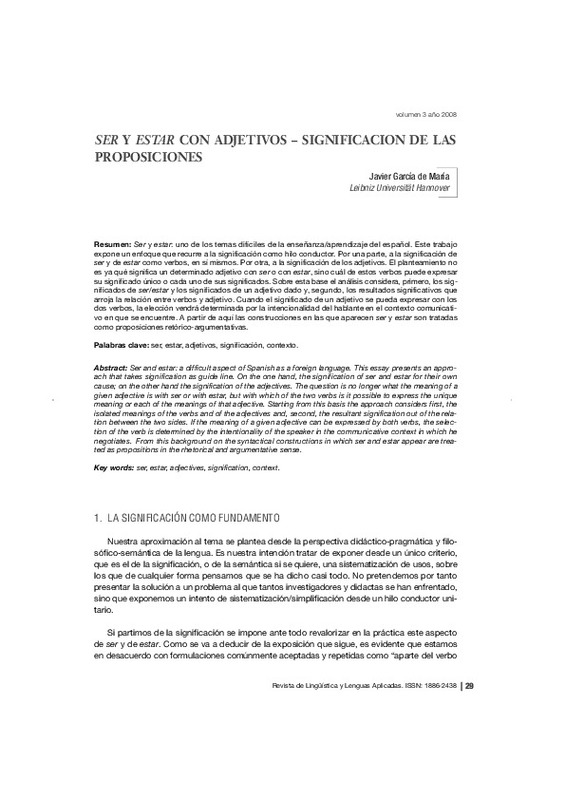JavaScript is disabled for your browser. Some features of this site may not work without it.
Buscar en RiuNet
Listar
Mi cuenta
Estadísticas
Ayuda RiuNet
Admin. UPV
SER Y ESTAR CON ADJETIVOS - SIGNIFICACION DE LAS PROPOSICIONES
Mostrar el registro sencillo del ítem
Ficheros en el ítem
| dc.contributor.author | García de María, Javier
|
|
| dc.date.accessioned | 2011-04-01T11:40:11Z | |
| dc.date.available | 2011-04-01T11:40:11Z | |
| dc.date.issued | 2008 | |
| dc.identifier.issn | 1886-2438 | |
| dc.identifier.uri | http://hdl.handle.net/10251/10639 | |
| dc.description.abstract | [EN] Ser and estar: a difficult aspecto of Spanish as a foreign language. This essay presents an approach that takes signification as guide line. On the one hand, the signification of ser and estar for their own cause; on the other hand the sifnification of the adjectives. The question is no longer what the meaning of a given adjective is with ser or with estar, but with which of the two verbs is it possible to express the unique meaning of the meanings of that adjective.Starting from this basis the approach considers first, the isolated meanings of the verbs and of the adjectives and, second, the resultant signification out of the relation between the two sides. If the meaning of a given adjective can be expressed by both verbs, the selection of the verb is determined by the intentionality of the speaker in the communicative context in which he negotiates. From this background on the syntactical constructions in which ser and estar appear are treated as proposistions in the rhetorical and argumentative sense. | es_ES |
| dc.description.abstract | [ES] Ser y estar: uno de los temas difíciles de la enseñanza/aprendizaje del español. Este trabajo expone un enfoque que recurre a la significación como hilo conductor. Por una parte, a la significación de ser y de estar como verbos, en sí mismos. Por otra, a la significación de los adjetivos. El planteamiento no es ya qué significa un determinado adjetivo con ser o con estar, sino cuál de estos verbos puede expresar su significado único o cada uno de sus significados. Sobre esta base el análisis considera, primero, los significados de ser/estar y los significados de un adjetivo dado y, segundo, los resultados significativos que arroja la relación entre verbos y adjetivo. Cuando el significado de un adjetivo se pueda expresar con los dos verbos, la elección vendrá determinada por la intencionalidad del hablante en el contexto comunicativo en que se encuentre. A partir de aquí las construcciones en las que aparecen ser y estar son tratadas como proposiciones retórico-argumentativas. | |
| dc.language | Español | es_ES |
| dc.publisher | Editorial Universitat Politècnica de València | es_ES |
| dc.relation.ispartof | Revista de Lingüística y Lenguas Aplicadas | |
| dc.rights | Reserva de todos los derechos | es_ES |
| dc.subject | Adjetivos | es_ES |
| dc.subject | Significación | es_ES |
| dc.title | SER Y ESTAR CON ADJETIVOS - SIGNIFICACION DE LAS PROPOSICIONES | es_ES |
| dc.type | Artículo | es_ES |
| dc.date.updated | 2011-03-31T13:34:17Z | |
| dc.identifier.doi | 10.4995/rlyla.2008.688 | |
| dc.rights.accessRights | Abierto | es_ES |
| dc.description.bibliographicCitation | García De María, J. (2008). SER Y ESTAR CON ADJETIVOS - SIGNIFICACION DE LAS PROPOSICIONES. Revista de Lingüística y Lenguas Aplicadas. 3:29-47. https://doi.org/10.4995/rlyla.2008.688 | es_ES |
| dc.description.accrualMethod | SWORD | es_ES |
| dc.relation.publisherversion | http://doi.org/10.4995/rlyla.2008.688 | |
| dc.description.upvformatpinicio | 29 | |
| dc.description.upvformatpfin | 47 | |
| dc.description.volume | 3 | |
| dc.identifier.eissn | 1886-6298 | es_ES |
| dc.description.references | Alcina Franch, J. y J.M. Blecua (1975). Gramática Española. Esplugues de Llobregat (Barcelo-na): Ariel. | es_ES |
| dc.description.references | Alonso Raya, R.; A, Castañeda Castro; P. Martínez Gila; L. Miquel López; J. Ortega Olivares y J.P. Ruiz Campillo (2005). Gramática básica del estudiante de español. Barcelona: Difusión. | es_ES |
| dc.description.references | De Molina, J.A. y J. Ortega Olivares (1987). Usos de "ser" y "estar". Madrid: SGEL. | es_ES |
| dc.description.references | García de María, J. (1999). "A favor, en contra, indecisión: tres usos argumentativos del subjuntivo", en W., Altmann y U., Vences (eds.) Vom Lehren und Lernen. Neue Wege der Didak-tik des Spanischen. Berlin: Tranvía / Verlag Walter Frey: 97-114. | es_ES |
| dc.description.references | García de María, J. (2001). "La pasiva desde la perspectiva del uso genérico o específico de las proposiciones", en M., Bargalló y E., Forgas (eds.) Las lenguas de especialidad y su didáctica. Tarragona: Universitat Rovira i Virgili: 381-390. | es_ES |
| dc.description.references | García de María, J. (2002). "El periodo condicional en el español para fines específicos. Usos argumentativos", en E., Hernández y L., Sierra (eds.) Lenguas para fines específicos(VII). Universidad de Alcalá: 49-55. | es_ES |
| dc.description.references | García de María, J. (2007). "El subjuntivo: nuevas reglas para nuevas estrategias", en Revista Nebrija, 1-1: 1-29. http://www.nebrija.com/revista-linguistica. | es_ES |
| dc.description.references | García Santos, J. F. (1993). Sintaxis del español. Nivel de perfeccionamiento. Madrid: Grupo Santillana. | es_ES |
| dc.description.references | Matte Bon, F. (1995). Gramática comunicativa del español. Tomo II: De la idea a la lengua. Madrid: Edelsa. | es_ES |
| dc.description.references | Moreno, C. (2001). Temas de gramática. Nivel superior. Madrid: SGEL. | es_ES |
| dc.description.references | Porroche Ballesteros, M. (1988). Ser, estar y verbos de cambio. Madrid: Arco/Libros. | es_ES |
| dc.description.references | Real Academia Española. (1991). Esbozo de una nueva gramática de la lengua española .Madrid: Espasa-Calpe. | es_ES |
| dc.description.references | Real Academia Española. (2004). Diccionario de la Lengua Española. http://www.rae.es | es_ES |
| dc.description.references | Sarmiento González, R. (1999). Gramática progresiva de español para extranjeros. Madrid: SGEL. | es_ES |








